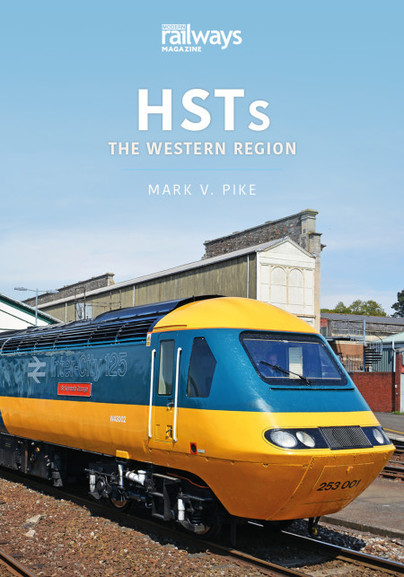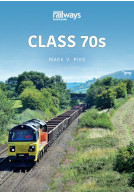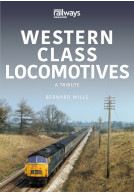HSTs: The Western Region (Paperback)
Imprint: Key Publishing
Pages: 96
Illustrations: 190
ISBN: 9781913870683
Published: 1st July 2022
(click here for international delivery rates)
Order within the next 9 hours, 38 minutes to get your order processed the next working day!
Need a currency converter? Check XE.com for live rates
Although in the late 1970s they were frowned upon by many for replacing a number of loco-hauled services, and indeed locomotives, for 40 years the High-Speed Train (HST) was the mainstay of express services for many train operators in the UK. It was in the former Western Region of British Rail that they first made their mark in service, and they were on duty there from their earliest days until 2019 when, after years of sterling work, they were withdrawn from frontline express duties. Illustrated with over 190 colour photographs, this book looks at the history of many of the power cars that worked in the region and details the varied Western Region locations, some off the beaten track, where they could be seen operating during their four decades of service.
This publication is essentially a record of the author’s photographs of HSTs from the mid 1980’s up to 2021, most of the photographs being taken post-privatisation. The author was somewhat sceptical of the HSTs’ potential longevity when they initially arrived at his local haunt, Exeter St David’s, remarking to his father in 1979 that they would not last!
Bradford Railway Circle "The Circular"
The book starts with a picture of prototype HST 41001 at the unlikely location of Corfe Castle parcels dock on the Swanage Railway, Dorset, where it was on display during the 2014 diesel gala. This image does highlight the shortcomings of the original external appearance of the design which was thankfully changed to that which we know today, by the British industrial designer Kenneth Grange. Whether this affected its success, we will never know but there is an adage in engineering “if it looks right, it is right” and the production version very definitely looked “right”.
By its very nature this book is essentially a photograph album featuring a large percentage of the HSTs that worked the Western Region, rather than a publication that majors on technical content. Consequently, what the book does do, is show off the class at a huge number of different locations, many of which have now changed beyond recognition, for example Didcot now bereft of its power station.
I am sure this book will be of great interest to not only class HST fans but other enthusiasts as well given the number and quality of the photographs contained within it.
As featured by
The Broad Gauge Society
BR’s High Speed Train ranks as one of the most successful designs across railway history, with many examples still in use today. With their use on GWR services likely to come to an end within the next year or so, the HST’s long association with Western Region routes is celebrated in this new paperback book.
Model Rail Magazine
Featuring nearly 200 high quality, colour images, the book deals mainly with the post-privatisation era, with just a handful of photographs from late BR days. Accordingly, the various liveries carried by the HSTs are detailed, with First Group blue dominating the bulk of the pages. Indeed, it’s the power cars that take centre stage throughout and the detailed captions provide plenty of useful information.
The story is brought up to date with a few images of Great Western’s short form ‘Castle’ sets at work. Numerous famous WR locations feature, including the seafront at Dawlish and Saltash viaduct, but the author has included many shots from less obvious locations, including diverted services using the ex-LSWR mainline. The images of HSTs trundling through Yeovil Pen Mill are an added bonus!
The Leyland Atlantean was Britain’s first successful rear-engined bus, and soon became a familiar sight on the nation’s streets, continuing so for several decades. It was also exported to many countries overseas in both right and left hand drive format and by the end of production its total worldwide sales had been massive.
West Somerset Railway Association
Veteran transport author Gavin Booth has showcased the Atlantean throughout its long life, from the very different looking early prototypes to the later production vehicles which are still so familiar to many. The book includes over 150 colour images showing the huge variety of body shapes and liveries carried by the Atlantean chassis over the years, ranging from the stylish offerings from the likes of Park Royal, Northern Counties and Van Hool McArdle to the clumsy and frankly rather ugly productions of the Pressed Metal Corporation of Australia and the one-off beast produced by Lancashire-based W & H Fowler. We also see that some Atlanteans received the angular and distinctive Nottingham style bodies seen on other chassis types, and that Portsmouth and Great Yarmouth even opted for single deck versions. An easy to read narrative accompanies the pictures, and the story is fleshed out by some useful contemporary drawings and cutaways explaining the layout of the bus and by rather charming trade advertisements from the 1950s.
Although essentially a colour album, this book also summarises some of the then revolutionary technical aspects of the marque, and can be recommended both as a useful introduction for beginners and as an easily digestible reminder of past glories for those of us who knew the Atlantean well.
This an excellent little book about this iconic class of locomotive in the Western Region. The thing I lied about it was the excellent background information about each photograph. Not just a short title.
James Simmonds
Another great book in this series
About Mark Pike
Mark Pike has a lifelong interest in UK railways that started at the age of about six when his father used to take him to watch trains at Poole station in Dorset, just after steam had been abolished in the late 1960s. He later joined the railway at the age of 19 as a permanent way trackman at Bournemouth and was later an electric track maintenance worker at Dorchester for over 20 years. Now semi-retired, he is still an avid railway photographer, with various images appearing regularly in mainstream railway magazines and books.




















